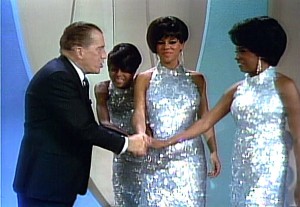If prime-time dramas and situation comedies of the civil rights era rarely featured African American actors or subject matter, many variety shows actively showcased black performers. The genre afforded these actors, singers, and comedians a national stage where they could perform at the highest level, in a context less threatening to white viewers.
If the variety programs’ support of black entertainers was, in part, an economic strategy—a means to reach out to an increasingly prosperous black middle class—it served the cause of civil rights by bringing accomplished African Americans into millions of living rooms on a regular basis. For black viewers, such performances were a source of pride and mainstream validation. For all viewers, these shows—exemplified by The Ed Sullivan Show (1948-1971), television’s most successful prime-time variety hour—demonstrated the promise and desirability of integration by presenting black and white professionals interacting as equals.
Image Credit
TV Still: The Ed Sullivan Show, c. 1968. (The Supremes)
